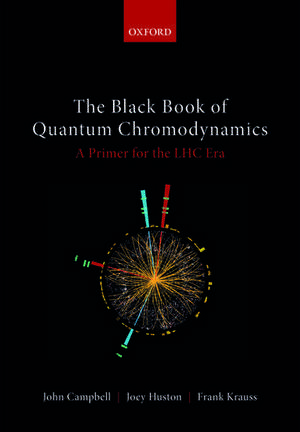The Black Book of Quantum Chromodynamics: A Primer for the LHC Era
Autor John Campbell, Joey Huston, Frank Kraussen Limba Engleză Hardback – 14 dec 2017
Preț: 494.05 lei
Preț vechi: 557.12 lei
-11% Nou
Puncte Express: 741
Preț estimativ în valută:
94.54€ • 103.01$ • 79.66£
94.54€ • 103.01$ • 79.66£
Carte tipărită la comandă
Livrare economică 12-18 aprilie
Preluare comenzi: 021 569.72.76
Specificații
ISBN-13: 9780199652747
ISBN-10: 0199652740
Pagini: 768
Ilustrații: 35 color and 270 grayscale line figures
Dimensiuni: 181 x 253 x 41 mm
Greutate: 1.59 kg
Editura: OUP OXFORD
Colecția OUP Oxford
Locul publicării:Oxford, United Kingdom
ISBN-10: 0199652740
Pagini: 768
Ilustrații: 35 color and 270 grayscale line figures
Dimensiuni: 181 x 253 x 41 mm
Greutate: 1.59 kg
Editura: OUP OXFORD
Colecția OUP Oxford
Locul publicării:Oxford, United Kingdom
Recenzii
The three authors of the Black Book of of Quantum Chromodynamics are leading world experts in the field and have produced an authoritative and comprehensive text on the subject. There is a wealth of information for students of particle physics and for researchers in high energy physics which has never before been collected together in one place.
...a comprehensive overview of the physics of the strong interaction.
This excellent and very timely book, written by leading practitioners in the study of strong interactions at hadron colliders, is incredibly broad, covering the full range of concepts and techniques necessary to understand this rich, complex and rapidly developing subject. It captures many of the recent technological advances in perturbative QCD in a clear and concise manner, and combines it with an insightful and comprehensive study of Tevatron and Run 1 LHC data. It is pitched at exactly the right level both to imbue theorists with the necessary depth of understanding of data and to introduce experimentalists to the advantages and disadvantages of different theoretical descriptions. It is a valuable resource one could use as a basis for a graduate course in collider physics, or for more experienced practitioners to dip into.
The complexity of carrying out precise experimental measurements at high-energy colliders such as the LHC is matched by the complexity of the calculations needed to attain the same level of precision in the theoretical predictions. In recent decades there has been significant progress in understanding how to manipulate the underlying quantum field theory, Quantum Chromodynamics, to enable such calculations to be performed. This book, written by world experts in the field, provides a magnificently comprehensive and accessible user guide to the concepts and techniques for doing precision QCD calculations for LHC physics.
I would like to congratulate the authors for producing such a comprehensive and up-to-date book on collider physics and the applications of perturbative QCD. This is a very useful book for both theory and experimental students and postdocs. The authors do a nice job in describing the evolution of our understanding of collider physics in going from the Tevatron to the LHC. The book is an excellent resource for high energy physics researchers, both young and old, as well as for a graduate course in modern particle physics.
The broad and overlapping expertise of the authors means that this book covers all the topics relevant to strong interactions at hadron colliders, from fixed-order QCD calculations to all-orders resummation, parton shower simulations and parton distribution functions, concluding with an excellent up-to-date review of the experimental data and future prospects.
...a comprehensive overview of the physics of the strong interaction.
This excellent and very timely book, written by leading practitioners in the study of strong interactions at hadron colliders, is incredibly broad, covering the full range of concepts and techniques necessary to understand this rich, complex and rapidly developing subject. It captures many of the recent technological advances in perturbative QCD in a clear and concise manner, and combines it with an insightful and comprehensive study of Tevatron and Run 1 LHC data. It is pitched at exactly the right level both to imbue theorists with the necessary depth of understanding of data and to introduce experimentalists to the advantages and disadvantages of different theoretical descriptions. It is a valuable resource one could use as a basis for a graduate course in collider physics, or for more experienced practitioners to dip into.
The complexity of carrying out precise experimental measurements at high-energy colliders such as the LHC is matched by the complexity of the calculations needed to attain the same level of precision in the theoretical predictions. In recent decades there has been significant progress in understanding how to manipulate the underlying quantum field theory, Quantum Chromodynamics, to enable such calculations to be performed. This book, written by world experts in the field, provides a magnificently comprehensive and accessible user guide to the concepts and techniques for doing precision QCD calculations for LHC physics.
I would like to congratulate the authors for producing such a comprehensive and up-to-date book on collider physics and the applications of perturbative QCD. This is a very useful book for both theory and experimental students and postdocs. The authors do a nice job in describing the evolution of our understanding of collider physics in going from the Tevatron to the LHC. The book is an excellent resource for high energy physics researchers, both young and old, as well as for a graduate course in modern particle physics.
The broad and overlapping expertise of the authors means that this book covers all the topics relevant to strong interactions at hadron colliders, from fixed-order QCD calculations to all-orders resummation, parton shower simulations and parton distribution functions, concluding with an excellent up-to-date review of the experimental data and future prospects.
Notă biografică
John Campbell is Senior Scientist at the Fermi National Accelerator Laboratory.Joey Huston is MSU Foundation Professor of Physics and Astronomy in the Physics and Astronomy Department at Michigan State University.Frank Krauss is Professor for Particle Physics at the Institute for Particle Physics Phenomenology and the Physics Department at Durham University.
